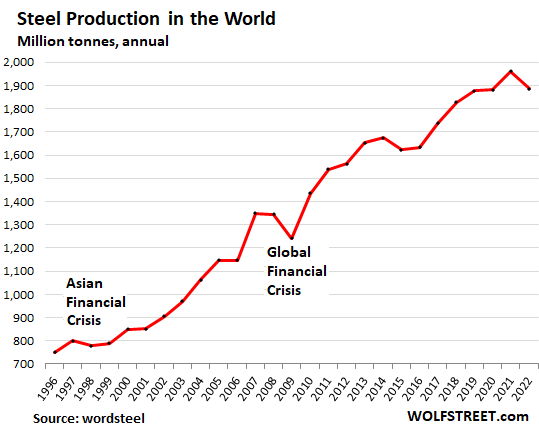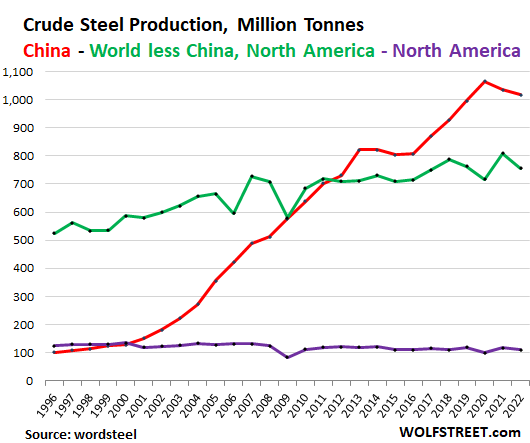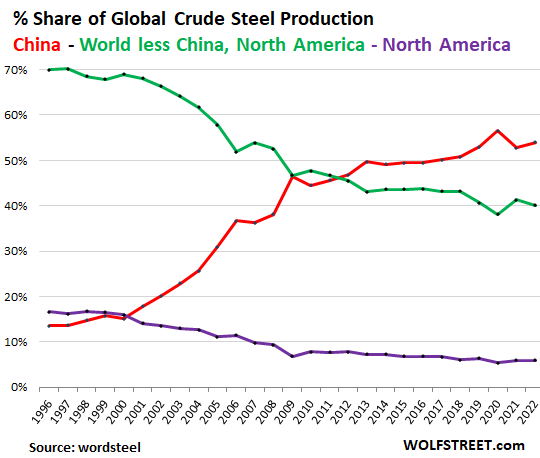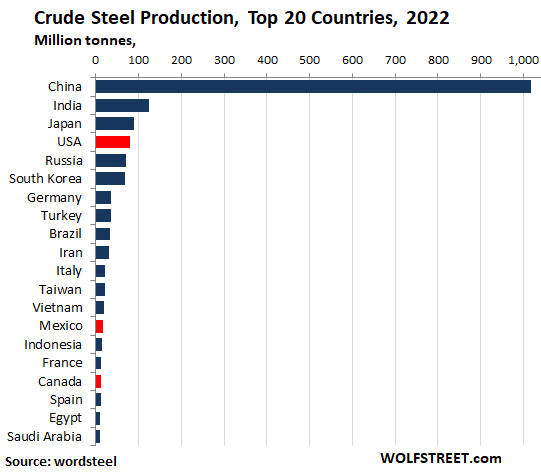China still produced more than the rest of the world combined, 12 times more than the US.
By Wolf Richter for WOLF STREET.
Global production of crude steel – ingots, semi-finished products (billets, blooms, slabs), and liquid steel for castings – fell by 3.9% to 1,885 million tonnes (Mt) in 2022, the first annual decline since 2015, the steepest decline since 2009, and the second-steeped decline going back to 1996, according to data from the World Steel Association. This brought production back to where it had been in 2020, thereby unwinding the stimulus-fueled jump in 2021.
Production in China, which produces over half the crude steel in the world, fell for the second year in a row, but this time less than in the rest of the world, and China’s share regained some of the ground it had lost in 2021.
There are now four episodes of falling annual crude steel production over the past 28 years:
- Asian Financial Crisis in 1998 (-2.7%);
- Global Financial Crisis in 2009 (-7.8%);
- The drop in 2015 (-3.0%);
- The stimulus-unwind in 2022 (-3.9%).

China v. the Rest of the World.
Since the year 2000, global crude steel production has surged by 122%, most of it in China: Over the period, China’s production exploded by 735%; North America’s production fell by 18%; and production in the rest of the world without China and North America rose by 29%.
In China, crude steel production in 2022 fell for the second year in a row, this time by 1.6%, to 1,018 Mt, after having fallen by 2.8% in 2021, which had been the largest decline in tonnage going back to 1996 (red line in the chart below)
In North America (US, Canada, Mexico), crude steel production has been wobbling lower below 1996 levels. In 2022, it fell 5.6% to 111 Mt, after the 16.6% surge in 2021. US production accounts for roughly three-quarters of North American production (purple).
In the rest of the world without China and North America, steel production fell 6.6% in 2022, after the 13.0% jumped in 2021 (green).

In 2020, the share of China’s steel production had jumped to a record 56.6% of global production. In 2021, the share fell to 52.7%. In 2022, as China’s steel production fell less than production in the rest of the world, its share ticked up to 54.0%.
North America’s share dipped to 5.9% in 2022. The share has been range-bound between 5.3% and 6.3% since 2017, after a long and steady downtrend from a share of 16.6% in 1996.
The share of the rest of the world without China and North America dipped to 40.1% in 2022:

Most of China’s crude steel production is used in China.
In 2022, China produced 54% of the world’s crude steel but used 52% of the world’s finished steel products – such as bar, pipe, and rolled steel – in its manufacturing and construction industries. This indicates that most of the crude steel produced in China was used in China’s manufacturing and construction sectors. China then exports large volumes of high-value manufactured products that are made of steel or contain steel, from appliances to bridge towers.
The top 20 steel-producing countries.
India (#2 in the world), Iran (#10), and Indonesia (#15) were the only three of the top 20 steel-producing countries where steel production rose in 2022 (by 5.6%, 7.0%, and 8.3% respectively). In the other 17 countries, production fell.
China’s production was 8 times the magnitude of India’s production and 12 times the magnitude of US production (#4). Production in the North American countries is marked in red:

The top 20 steel-producing companies.
The largest US steel producer, Nucor, ranks #16 globally. Eleven of the top 20 are Chinese companies. The second largest producer, ArcelorMittal, is a product of India’s giant Mittal Steel having acquired the French company Arcelor; now registered in Luxembourg and run from India.
| Top steel-producing companies | Mt | ||
| 1 | China Baowu Group | China | 131.8 |
| 2 | ArcelorMittal, includes 60% AM/NS India | Luxembourg, India | 68.9 |
| 3 | Ansteel Group, incl. Benxi | China | 55.7 |
| 4 | Nippon Steel Corporation | Japan | 44.4 |
| 5 | Shagang Group | China | 41.5 |
| 6 | HBIS Group | China | 41.0 |
| 7 | POSCO Holdings | South Korea | 38.6 |
| 8 | Jianlong Group | China | 36.6 |
| 9 | Shougang Group | China | 33.8 |
| 10 | Tata Steel | India | 30.2 |
| 11 | Shandong Steel Group | China | 29.4 |
| 12 | Delong Steel | China | 27.9 |
| 13 | Hunan Steel Group | China | 26.4 |
| 14 | JFE Steel Corporation | Japan | 26.2 |
| 15 | JSW Steel Limited | India | 23.4 |
| 16 | Nucor Corporation | United States | 20.6 |
| 17 | Fangda Steel | China | 19.7 |
| 18 | Hyundai Steel | South Korea | 18.8 |
| 19 | Liuzhou Steel | China | 18.2 |
| 20 | IMIDRO | Iran | 18.0 |
Enjoy reading WOLF STREET and want to support it? You can donate. I appreciate it immensely. Click on the mug to find out how:
![]()


I wonder how much of that huge volume of steel is being used in military applications; I would guess a substantial portion. China is already the arsenal of autocracy; the West should be thinking about what the world will be like in five years if China keeps building its military capacity at the current rate. It looks like the West’s grand plan to help China modernize and develop hasn’t turned out as planned.
I think you massively underestimate the quantity of steel required for civilian uses, particularly in China. Military demand would almost certainly be less than 1%.
A long way from a substantial portion.
How can you possibly prove this given China’s enforced policy of “military-civil fusion”?
I had a rep for a metal can manufacturer from Italy call me today.
Supposedly, even with shipping the cans across the pond in containers, they are competitively priced. I haven’t seen the pricing yet.
Once you’ve sunk CAPEX, you’re likely willing price pretty damn close to OPEX in the hope of a brighter future. And still being in business when it arrives.
Same dynamic applies to ships as well as cans.
And Italy is regressing economically – 140% G debt-to-GDP didn’t magically enrich the nation…a lesson for US. Apparently even the Italian demand for *cans* is shrinking…not a great sign.
Barely on topic, but I am not a big steel purchaser (duh). But at my local Home Despot the steel roofing nails I just bought were made in Vietnam (of all places). Hard to find USA-made items at HD.
I can think of a lot of Home Depots that I’ve driven past. I can’t think of any nail factories i’ve driven past. The few that I can possibly think of were likely warehouses with nails and fasteners at best. Polls show people like to go to The Home Depot. Polls also show people don’t like to go to The Nail Factory. Too much money in peoples pockets. Start using poor stitching on pockets of pants and people will lose their money, get hungry, and then want to go to he nail factory for work.
For want of a nail (factory) the nation was lost…
I wonder if any economists are honestly revisiting their near-religious faith in the “irrelevance” of trade deficits (almost as bad as the MMT’ers, becoming they are..).
Perpetual trade deficits result in astronomical stacks of future claims against US accumulated wealth…all held by foreign interests.
Hasn’t it occurred to any mainline economists that perhaps some of the overvaluation of US assets (both financial and real) is being driven by those huge offshore stacks of claims being recycled back to the US – and not just into DC treasuries.
Maybe the true price of that overpriced iPhone made in China, is soaring housing prices/rents in the US.
US consumer goods financed by foreign countries, secured by US housing inter-temporally…a pretty shitty trade for the US.
Next up, shiny beads in exchange for your daughters…
FAST
Just the ticker symbol alone makes me happy to own a few shares. Fastenal Company, Winona, Minnesota has 20,262 full time employees.
You want some nails? How about 5,000 18 gauge 1-1/4″ Smooth Shank Diamond Point Electro-Galvanized Pneumatic Brad Nails?
That’ll be $26.71 per box; online price. Manufactured by Kyocera Senco Industrial.
Wolf would love to Nordic ski in Winona come winter time. On the west bank of the Mississippi with some fairly steep hills. Beautiful scenery and lots of eagles nesting.
Prairie Rider posted a valueless comment trying to shill a ticker. Please delete.
Yeah but how much for one 3-Penny nail?
yield_curve_believer,
Shilling was not my intention. And Wolf can advise me if it was and pull it.
There is a Minnesota company that deals in industrial fastening products, many of which are made out of steel. This company sells nails — lots of them. But it seems that they are not made in the USA. I wish that we had a manufacturing base in the USA to produce things like nails to be fired out of air-guns. But as ‘MiTurn,’ ‘Question Everything,’ and ‘Cas127’ commented above me, it appears that we do not. Just a confirmation in my reply, eh?
But, yeah, I do like the ticker symbol as I’m an adrenaline junky.
“Sono il vecchio gato veloce.”
Bad news for Australia, Brazil if true
Under the section starting with “In China,…”
Should 1.018 Mt be 1.018Bt?
Or 1,018Mt?
comma. Thanks.
With 3/4 of North American steel made in the USA, it looks like Mexico would have an opportunity to import crude steel from China and finish it here in North America at a highly competitive rate.
By old industyr area metrics, the Chinese economy is then the biggest in the world.😉
Ok China is a large country, but still there must be a large amoount of building and constuction going in there. And they must be a large exporter of goods where steel is part of the product.
It has the largest construction industry in the world and is the largest exporter in the world. It has the largest auto market in the world, both production and sales (since ca.2014). It’s the largest in many things but not all, including all-important services.
The CCP is also the monopoly supplier of internal Chinese economic data. A lot of Chinese numbers are way too high, including their own population size. Party bosses can punish “wrong” numbers with anything from zero social credit via jail time to death penalty.
Some foreign analysts now resort to satellite picture trying to check certain make-believe numbers.
In that global chart, South Korea with only a ~50mn population, punches way above it’s size! As does Taiwan (~25mn population)!
Posco is legit! Stock pays good dividend
So Mak you say that steel for “Military demand would almost certainly be less than 1%.”
By your number of 1% that means 52% of the WORLD’S output, – don’t you thank that’s a lot?????? and Where do you get this fact?
Don’t you see that their navy, air force, and all kinds of military equipment is escalating, AND trying to intimidate our warships and warplanes??????
I said 30 years ago that all this trade and building up China would lead them to be a world military power and I was laughed at, and today nobody laughs at me!!
A good percentage of China products bought goes right into their military might, – check out the number of warships and fighter jets each country has.
Where do you get all this nonsense.
1% of 1000 M-Tons is only 10MT and that is only 10% of what India produced.
Look at how many sky rises and high speed rail that China had built in the past decade. Sure, some of the steel will be used in their military but looking how extended our military compared to China — I am not sure we can complain too much.
Chairman Xi is quoted as saying he wants the military to become a “Great Wall of Steel”. The Chinese military will get as much steel as it wants from the huge pool of Chinese production for shipbuilding and armaments and inevitably will become the largest conventional force in the world.
Occam – you got that right, too many others don’t read the military news or comprehend it.
LOL – Get educated about China’s military.
44.2% of all ships are build in china. That takes a lot of steel. (USA is below 0.1%)
And think shipping containers etc…
And they teach there people to hate the west,but they better get in line . Seems we’re not liked much in any part of world
I started buying steel in 1987. Back then you could not even buy Chinese Steel . It did not even become available on the American market until the late 90’s. And from then till the mid 2000’s it was mostly junk and nobody wanted it except for the cheapest markets ( Manufactured Home Frames, etc). Strangely we have never been able to get much US made steel on the West Coast, even back in the 80’s because overland shipping costs more than by ship. Nucor’s Mini-mills ( melt down scrap) don’t normally make the kind of steel I use and they are the only ones in the West. We used to get a lot of steel from Canada. That all changed around 2008 and now most common steels are from China. The specialty stuff still comes from the US, Germany, and Japan.
Wolf ,all comments go to moderation .
Yes, I’m going to hold your hand for a while.
“All things in moderation.”
K I probably need a break
You’re doing fine. Just let me hold your hand for a little while. The problem is that you’re picking up some crazy stuff on YouTube or wherever and you’re dropping this crazy stuff in here in as one-liners. A little bit of that is OK, and can be fun, but is has gone a little too far.
How much steel is produced as recycled product in a post industrial economy such as the US? Is it a significant proportion of total steel used annually?
China’s accession to the WTO in 2001, which was the culmination of Jiang Zemin‘s “socialist market economy” reform era has to be one of the lesser appreciated, yet pivotal events of our generation. The resulting integration of China into the broader world economy is one of the key factors which facilitated that breakneck upward sloping growth in many economic indicators since the turn of the century.
Looking to the future, it will be fascinating to watch how China’s demographic challenges and the subsequent effect on both demand there, as well as its ability to produce will challenge its economic growth in the coming generation.
I was told by delivery driver for Local steel supplier, that they weren’t ever that slow. His daily delivery load is 1/4 of what it was 2 years ago.
When the Chinese finally begin to slow, then they will wipe out any older slower non tariff protected steel industry in the rest of the world. Then they will wipe out their oldest plants to cut pollution.
Begin dumping now!
And the Ukraine has been forcibly deindustrialized out of the raw markets.
But still, a huge chunk of the third world looks like Indonesia, cheap coal with plenty of cheap labor, along with infrastructure needs out the wazoo.
Steel, the 19th century power base.
Someday this war’s gonna end…
Steel making is extremely hard work. Yes the plants are largely automated but you still needs lots of hard working bodies in the plant. And forging steel, even more labor intensive depending on the shape and size of the forged piece.
For all those questioning why America doesn’t make steel (or anything else that requires hard work) anymore, the answer is simple. The financialized model cooked up by Clinton was to not fight the loss of industry overseas, but instead embrace it and let American companies benefit from the cheap labor, nasty environmental impacts and other arbitrages.
Again, all this works as long as the dollar is king and massive trade deficits fuel our nation’s debt. It won’t be working much longer, I feel sure. So we will start making a lot of stuff again, in smaller quantities, and people will actually have to start working again. I mean real working for a lot less than he steel workers of the past century and particulalry when adjusted for inflation/cost of living.
Yeah right, let blame the Clintons. Let not blame the for profit model that we have. Companies exit to make money and they will do it anyway they could. We don’t want hard work. Period. Just ask the youngsters for their opinions and see if all of these “hard” work are coming back here. It’s easier to sit around and passing the blame.
No company would want to pay US worker $50/hr if they can get somewhere else for $5. Ask Nike, ask Apple, etc… The execs of these companies will try to maximize their profit for their shareholders (mostly US pensioners).
See: The Competitive Advantage of Nations – Michael E. Porter
https://hbr.org/1990/03/the-competitive-advantage-of-nations#:~:text=A%20nation's%20competitiveness%20depends%20on,suppliers%2C%20and%20demanding%20local%20customers.